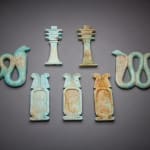Group of seven Egyptian faience inlays, 664 BCE - 525 BCE
Faience
height 12.4 cm
height 4 7/8 in
height 4 7/8 in
X.0181
Further images
-
(View a larger image of thumbnail 1
)

-
(View a larger image of thumbnail 2
)

-
(View a larger image of thumbnail 3
)

-
(View a larger image of thumbnail 4
)

-
(View a larger image of thumbnail 5
)

-
(View a larger image of thumbnail 6
)

-
(View a larger image of thumbnail 7
)

-
(View a larger image of thumbnail 8
)

This group of seven plaques in turquoise-blue faience, consist of two sacred cobras, two djed-pillars, considered by some scholars as representations of the spinal column of Osiris and by others...
This group of seven plaques in turquoise-blue faience, consist of two sacred cobras, two djed-pillars, considered by some scholars as representations of the spinal column of Osiris and by others as reeds bundled together, and three cartouches, without inscription, each crowned by two ostrich feathers. The shape of the inlays suggests their use as inlays set into decorative wooden panels. The repeated motifs suggest that such inlays composed identical hieroglyphic phrases which were decoratively repeated.
The use of inlays has a long tradition in ancient Egyptian art, but prior to Dynasty XXVI, each such elements were relatively small in size. The scale of our ensemble, therefore, indicates that these seven inlays were created during Dynasty XXVI (664-525 BC), when such large-scale inlays were extremely fashionable.-known series, one example of which was inscribed with hieroglyphs which seemed to indicate a dating within Dynasty XXVII (525-404 BC) for the group. The Twenty-sixth Dynasty of Egypt (notated Dynasty XXVI, alternatively 26th Dynasty or Dynasty 26) was the last native dynasty to rule Egypt before the Persian conquest in 525 BC. The dynasty's reign (664–525 BC) is also called the Saite Period after the city of Sais, where its pharaohs had their capital, and marks the beginning of the Late Period of ancient Egypt.
[1]References:
See Robert Steven Bianchi and Florence D. Friedman in F. D. Friedman [editor], Gifts of the Nile. Ancient Egyptian Faience (Providence 1998), cat. no. 61.
The use of inlays has a long tradition in ancient Egyptian art, but prior to Dynasty XXVI, each such elements were relatively small in size. The scale of our ensemble, therefore, indicates that these seven inlays were created during Dynasty XXVI (664-525 BC), when such large-scale inlays were extremely fashionable.-known series, one example of which was inscribed with hieroglyphs which seemed to indicate a dating within Dynasty XXVII (525-404 BC) for the group. The Twenty-sixth Dynasty of Egypt (notated Dynasty XXVI, alternatively 26th Dynasty or Dynasty 26) was the last native dynasty to rule Egypt before the Persian conquest in 525 BC. The dynasty's reign (664–525 BC) is also called the Saite Period after the city of Sais, where its pharaohs had their capital, and marks the beginning of the Late Period of ancient Egypt.
[1]References:
See Robert Steven Bianchi and Florence D. Friedman in F. D. Friedman [editor], Gifts of the Nile. Ancient Egyptian Faience (Providence 1998), cat. no. 61.







